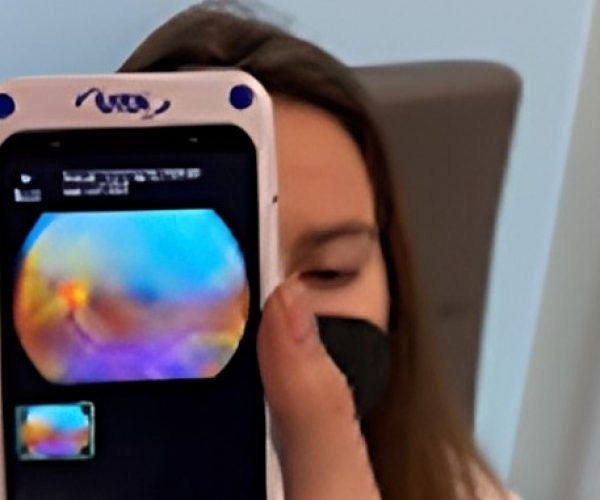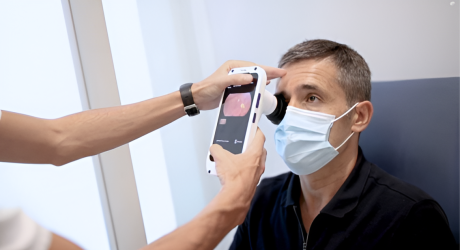Retina Read Risk to the test: a solution for a better screening of a diabetes-related eye disease
The Retina Read Risk consortium has been working for a year on the design of a screening solution for diabetic retinopathy, an eye disease due to diabetes. Building on its progress, the consortium has finalized its prototype and launched a full-scale test in Spain in 2022.
A reminder on diabetic retinopathy
The number of people affected by diabetes is estimated to be 537 million worldwide or more than one in ten adults by 2021. In Europe, this represents 61 million people[i].
It is estimated that nearly one million people suffer from visual impairment or blindness due to diabetic retinopathy in the European region, according to the World Health Organisation (WHO)[ii]. In Spain, according to local experts, the incidence of this pathology is on the rise[iii].
Diabetic retinopathy is an eye disease resulting from the onset of diabetes. It is caused by an excessive sugar concentration in the blood circulating in small blood vessels in the retina. This disrupts their function and can lead to tissue swelling (edema), retinal detachment, impact the function of optic nerves and even cause blindness if left untreated.
The real risk is that the disease is silent. It progresses without causing any apparent discomfort until very late in its development. For these reasons, diabetes management programs automatically include annual or biennial screening through the performance of a fundoscopy (to examine the fundus of the eye) by an ophthalmologist, anorthoptist, or another qualified professional.
The right preventive actions
The best way to prevent diabetic retinopathy in the general population is to take preventive measures against type 2 diabetes, by adopting a healthy life and avoiding excess body weight.
For the diabetic population, the main risks come from the persistence or regular occurrence of excessive blood sugar levels (hyperglycemia). One of the main protective factors is therefore blood sugar control, which implies regular monitoring of blood sugar levels, an appropriate diet, potential medical treatment, and monitoring of blood pressure (often associated with type 2 diabetes) as indicated by the endocrinologist or the physician treating the patient.
Certain behaviors and lifestyles also decrease the risk of developing diabetic retinopathy, such as quitting smoking, reducing alcohol consumption, practicing regular physical activity, and protecting the eyes from exposure to UV light.
The reality of screening
In France, approximately one-third of patients have not undergone a fundoscopy over the period specified by the public health authority[iv]. This stable trend since 2019 reflects difficulties in carrying out the screening, despite large efforts from the government in prevention actions at the end of the 2010s. In Spain, the situation is even worse as only 33% of patients undergo screening for diabetic retinopathy.
A qualitative study[v] indicated that there is a real difficulty for doctors to make their patients aware of the challenges of screening, as professionals qualified to carry out a fundoscopy lack time and availability.
Furthermore, the distribution of ophthalmologists is indeed not homogenous and concentrated in major cities. In France, the wait time for scheduling a follow-up appointment is doubled in small cities compared to the Paris agglomeration. In Spain, the average wait time for an ophthalmologist appointment is 74days[vi] but there are huge variations according to region, from a 60-day wait time in the surroundings of Madrid[vii] to 140 days in the Canary islands[viii].
Retina Read Risk
The aim of this solution is to provide a portable and easy-to-use tool to medical staff who carry out scheduled monitoring of diabetics. The tool (represented on the left) consists of (i) a device, containing a lens, which is placed on a smartphone camera, to capture the fundus images, (ii) a questionnaire filled with patient information and (iii) an application with an AI (artificial intelligence) for analysis. The application gives a recommendation to the medical professional, which will help them evaluate the partient’s risk of developing the disease. This solution should improve support for people at risk in the care pathway, and reduce the pressure on the care system for the screening of this disease.
The consortium gathered around Retina Read Risk has finalized the technological choices during the first half of 2022, leading to the production of the first prototype of the solution at the beginning of summer.
Initial tests were carried out during 2022 with Catalan doctors, on the one hand to obtain retina images to train the AI algorithms, and on the other hand to evaluate the usability of the device.
Retina Read Risk already allowed for more than 485 screenings in Spain. It detected retinopathy in 28 at-risk patients and addressed 57 patients for fundoscopy. The clinical study will continue in 2023, but a medico-economic study already shows a lot of benefits to the use of retina-read-risk for cost-saving in health prevention.
To stay in touch with this project, please subscribe to the newsletter: https://forms.gle/2vzQeq4fkrTq5DPWA
[i] International Diabetes Federation Diabetes Atlas 10th edition, 2021 : link
[ii] Flaxman et al. Global causes of blindness and distance vision impairment 1990–2020: a systematic review and meta-analysis, 2017 The Lancet, Volume 5, Issue 12, December 2017, Pages e1221-e1234
[iii] Romero-Aroca P, Navarro-Gil R, Valls-Mateu A, et al, Differences in incidence of diabetic retinopathy between type 1 and 2 diabetes mellitus: a nine-year follow-up studyBritish Journal of Ophthalmology 2017;101:1346-1351
[iv] Caisse Nationnal d’Assurance Maladie(cnam), La Rémunération sur objectifs de santé publique (Rosp) en 2021, Avril 2022 – link
[v] Watson, M.J.G., McCluskey, P.J., Grigg, J.R. et al. Barriers and facilitators to diabetic retinopathy screening within Australian primary care. BMC Fam Pract 22, 239 (2021). https://doi.org/10.1186/s12875-021-01586-7
[vi] Listas de espera en la Sanidad pública, EpData, últimos datos oficiales,Datos actualizados el 25 de noviembre de 2022, link
[vii] La demora media para acudir a una consulta externa se sitúa en 60 días,El Adelantado de Segovia, 18 abril, 2022, link




